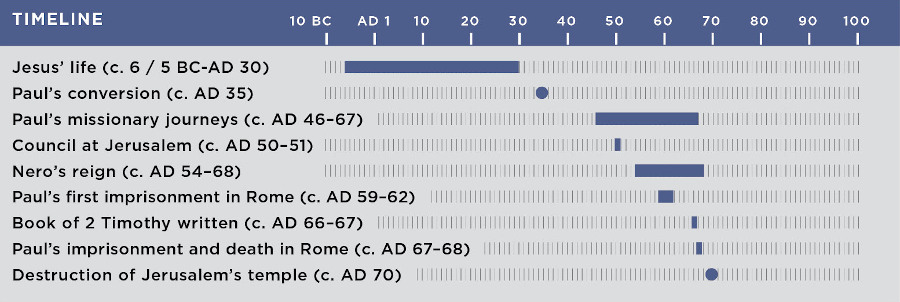

Author: The apostle Paul
Audience: Paul’s disciple Timothy, who was ministering in Ephesus
Date: Probably about ad 66–67, but possibly 62
Theme: Facing imminent death, Paul encourages Timothy to carry on the ministry and faithfully guard the gospel in the face of persecution and false teaching.
Introduction
Author, Date and Setting
![]() See article. After Paul’s release from prison in Rome in ad 62 (Ac 28) and after his fourth missionary journey (see map and accompanying text), during which he wrote 1 Timothy and Titus, Paul was again imprisoned under Emperor Nero c. 66–67. It was most likely during this time that he wrote 2 Timothy (see chart), though if 1 Timothy were written in ad 56, 2 Timothy could come from Paul’s Roman imprisonment at the end of Acts, and thus from c. ad 62 (see article; see also Introduction: Date). On the main view, in contrast to his first imprisonment when he lived in a “rented house” (Ac 28:30; see note there), he now languished in a cold dungeon (see 4:13 and note), chained like a common criminal (1:16; 2:9). His friends even had a hard time finding out where he was being kept (1:17). Paul knew that his work was done and that his life was nearly at an end (4:6–8). This is his last letter.
See article. After Paul’s release from prison in Rome in ad 62 (Ac 28) and after his fourth missionary journey (see map and accompanying text), during which he wrote 1 Timothy and Titus, Paul was again imprisoned under Emperor Nero c. 66–67. It was most likely during this time that he wrote 2 Timothy (see chart), though if 1 Timothy were written in ad 56, 2 Timothy could come from Paul’s Roman imprisonment at the end of Acts, and thus from c. ad 62 (see article; see also Introduction: Date). On the main view, in contrast to his first imprisonment when he lived in a “rented house” (Ac 28:30; see note there), he now languished in a cold dungeon (see 4:13 and note), chained like a common criminal (1:16; 2:9). His friends even had a hard time finding out where he was being kept (1:17). Paul knew that his work was done and that his life was nearly at an end (4:6–8). This is his last letter.
Reasons for Writing
Paul had at least three reasons for writing to Timothy at this time:
![]() (1) Paul was lonely and longed for Christian fellowship. Phygelus and Hermogenes, “everyone in the province of Asia” (1:15), and Demas (4:10) had all deserted him. Crescens, Titus and Tychicus were away (4:10–12), and only Luke was with him (4:11). Paul wanted very much for Timothy to join him also. Timothy was his co-worker (Ro 16:21), who “as a son with his father” (Php 2:22; see note there) had served closely with Paul (1Co 4:17). Of him Paul could say, “I have no one else like him” (Php 2:20). Paul longed for Timothy (1:4) and twice asked him to come soon (4:9,21). For more information on Timothy, see Introduction to 1 Timothy: Recipient.
(1) Paul was lonely and longed for Christian fellowship. Phygelus and Hermogenes, “everyone in the province of Asia” (1:15), and Demas (4:10) had all deserted him. Crescens, Titus and Tychicus were away (4:10–12), and only Luke was with him (4:11). Paul wanted very much for Timothy to join him also. Timothy was his co-worker (Ro 16:21), who “as a son with his father” (Php 2:22; see note there) had served closely with Paul (1Co 4:17). Of him Paul could say, “I have no one else like him” (Php 2:20). Paul longed for Timothy (1:4) and twice asked him to come soon (4:9,21). For more information on Timothy, see Introduction to 1 Timothy: Recipient.
(2) Paul was concerned to pass on the mantle of Christian leadership. He admonished Timothy to guard the gospel (1:14), to persevere in it (3:14), to keep on preaching it (4:2) and, if necessary, to suffer for it (1:8; 2:3).
(3) Paul wanted to write to the Ephesian church through his letter to Timothy (see note on 4:22).
In this letter Paul admonishes Timothy to guard the gospel, to persevere in it, to keep on preaching it and, if necessary, to suffer for it.
Outline
I. Introduction (1:1–4)
II. Paul’s Concern for Timothy (1:5–14)
III. Paul’s Situation (1:15–18)
IV. Special Instructions to Timothy (ch. 2)
A. Call for Endurance (2:1–13)
B. Warning About Foolish Controversies (2:14–26)
V. Warning About the Last Days (ch. 3)
A. Terrible Times of False Teaching (3:1–9)
B. Means of Combating Them (3:10–17)
VI. Paul’s Departing Remarks (4:1–8)
A. Charge to Preach the Word (4:1–5)
B. Paul’s Victorious Prospect (4:6–8)
VII. Final Requests, Greetings and Benediction (4:9–22)


